Mirosławiec 2011-03-14
Military airport in Mirosławiec.
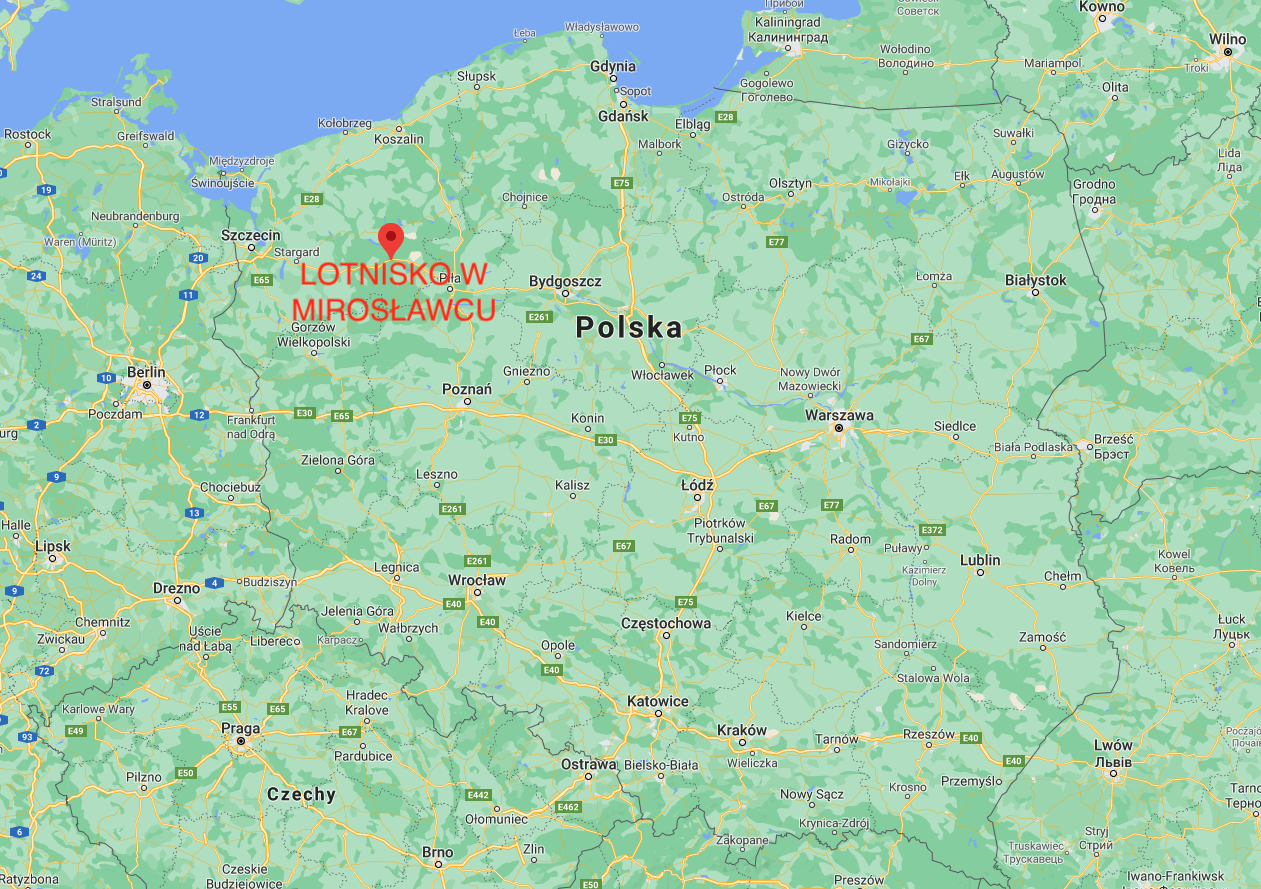
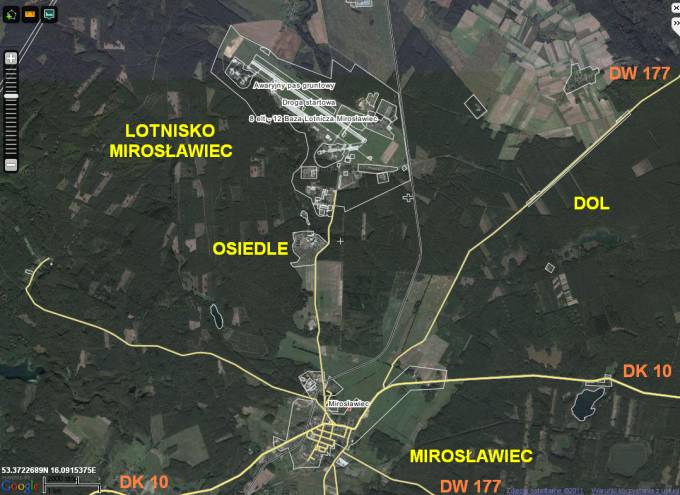
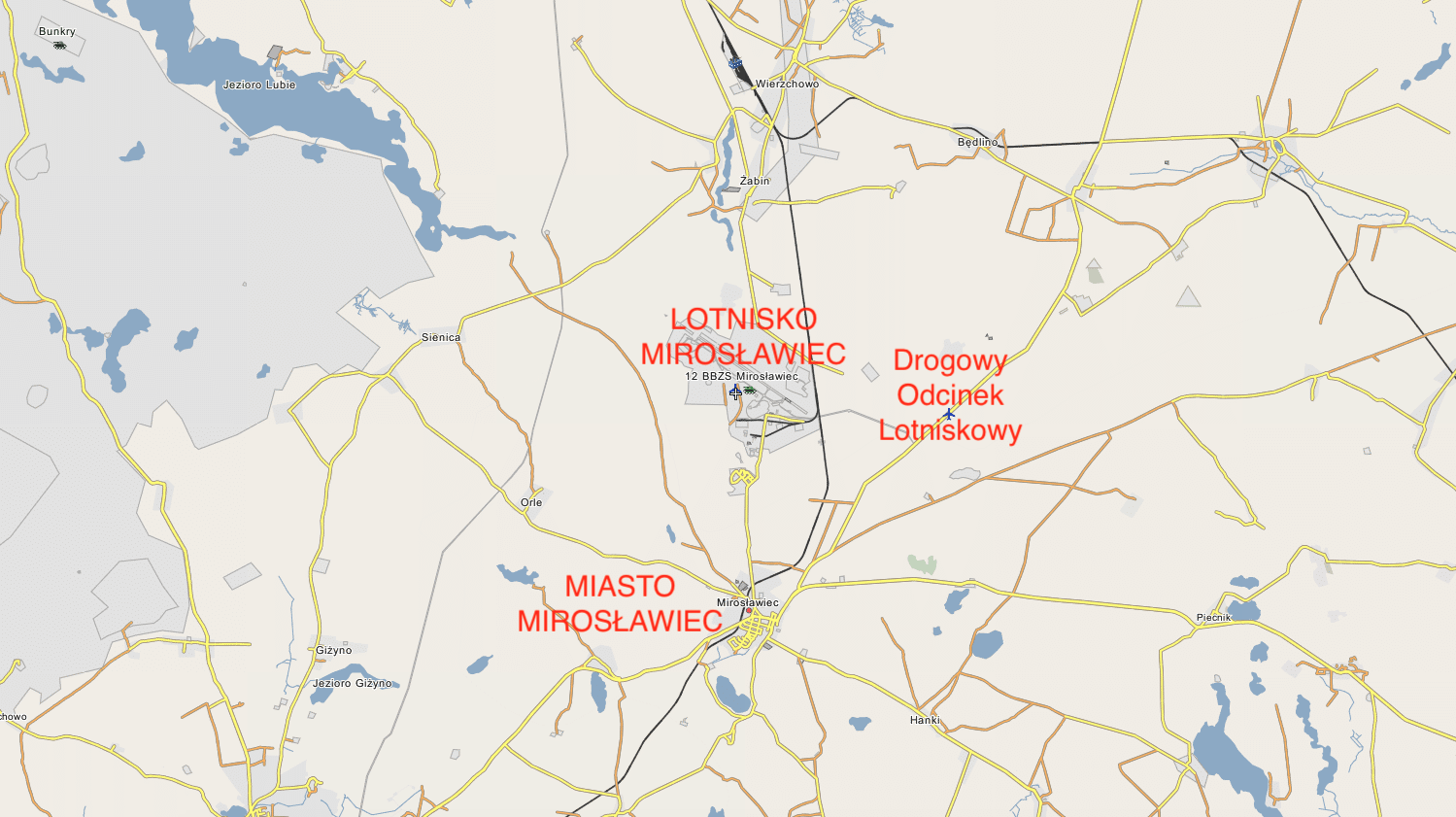

History of Mirosławiec and its vicinity.
It is not known when the settlement, which we call the City of Mirosławiec today, was established, but probably in the 10th century there was a small stronghold here. It was created on the route leading from the east to the west, from today's Bydgoszcz to today's Szczecin. But above all, on the so-called salt trail from Kołobrzeg into the interior of the Polish-Lithuanian Commonwealth. Undoubtedly, the town of interest to us belonged to the Piast dukes. In 1296. Przemysław II - King of Poland and Duke of Pomerania - dies. A confusion breaks out in Poland, which is exploited by the Brandenburg margraves. They mastered around 1300. areas between rivers; Drawa and Gwda. They began an intensive colonization using mainly the Germanic element. Mirosławiec probably received city rights as early as 1303. In written transmissions, the city is mentioned for the first time in a privilege issued on 02/02/1314, in which brothers Henryk and Jan from the Wedel family confirmed the city rights of Brandenburg. The founders of the city were Mikołaj and Jan Knobelsdor, and the city councilors were witnesses to this act. As we can see, the Brandenburgers followed the fait accompli method. The Wedel family, originating from the indigenous Brandenburg Marchia, stood out in the colonization action. The city unexpectedly found itself on a new route - the road connecting the Marches with the Teutonic state, when in 1309, the Teutonic Knights seized Pomerania. In 1314. the boundaries of the city have been carefully marked out and the sources of income have been defined; granting land, hunting rights, trade fees for bread, meat and craft stalls. The spatial shape that the city received as a result of its location was similar to a rectangle with a regular network of streets. The small rectangular market square was located asymmetrically on the northern side of the shorter axis of the system, transversely to the longer axis of the foundation. The street routes parallel to the longer axis of the complex, led tangentially to the shorter market frontages, were connected by utility streets separating appropriate blocks of buildings. Two inlet arteries led perpendicular to the shorter sides and coinciding with the longer axis of the market square. On the transverse axis of the complex there was a parish church (mentioned in 1641 as a brick church) with a separate cemetery, in the vicinity of which at that time there was a brick school and a rectory. The parish founded in the 14th century belonged to the Poznań Diocese until the Reformation was introduced in 1543. It is not known whether Mirosławiec had defensive walls or only earth ramparts. Access to the city led through three entrance gates: the Grobelna Gate from the north-east, the Hunting Gate from the west and the Mill Gate from the south.
The main issue of Polish foreign policy of the fourteenth and fifteenth centuries was the issue of the Teutonic Knights. Attempts to move in 1325. the border via Władysław Łokietek from Noteć beyond the Drawa River ended in failure. Only in 1364. the areas on the Noteć River were honored for the benefit of the Polish Crown for individual families from the border. In 1365. The Wedel of Tuczno and Złocieniec recognized the sovereignty of the Polish King, and in 1368, Casimir the Great regained the Wałcz Land, but without Złocieniec and Kalisz. After the death of Casimir the Great, disputes flared up on the border again, and the Polish-Teutonic conflict intensified. Ultimately, the resolution of the conflict took the form of an armed struggle, culminating in the victory of Poland at Grunwald in the first phase. The power of the order was finally broken only by the Thirteen Years' War, and as a result of the Toruń in 1466. Poland regained peace in Pomerania. Probably as a result of border riots there was a fire in the city around 1395. The city was captured by the Teutonic Knights for several months. In 1554. The city was consumed by a fire with many victims. Only 67 families survived.
The borderland was always turbulent and dangerous, and the vast forests were conducive to robberies, in which also knightly families were engaged. The nobility in the Wałcz County was known for their audacity and lawlessness. The most famous inn in the district of Wałcz, which was a form of administering justice on their own, was the expedition of the Golce, Borek, Guntersberg and Smiełowski families to Mirosławiec in 1594.
Cities owned by only one lord (family), such as Mirosławiec, did not develop dynamically. The Lord forced various obligations on the townspeople, so that they sought help from the starosts, and even from the King himself. These interventions did not bring the expected results. The location of Mirosław created favorable conditions for trade, which began to develop especially from the 16th century. As a result, at the end of the 16th century, Germans, Scots and Jews began to arrive in Mirosławiec and similar towns, who received better conditions for trading than the natives. The then owner of Mirosławiec, Mirosław Henryk von Blankenburg, only demanded that they pay taxes diligently. Initially, Jews were not allowed to settle in the City itself, but that quickly changed. A synagogue and a rabbinical school were built. Merchants from Mirosławiec maintained extensive trade contacts. The items of trade were wool, grain, leather, feathers, cloth, rope products and honey.
At the end of the 18th century, when the area of interest to us was already under Prussian rule, the economic decline of the city began. Only cooperage, brewing and agriculture functioned. Cloth making, tailoring and shoemaking fell into decline. The Thirty Years' War and the Napoleonic Wars at the beginning of the 19th century also contributed to all of this. The fires destroyed the wooden buildings of the City, and requisitions and contributions as well as common robberies took away the townspeople's property, merchants' goods and money, and craftsmen's working tools.
In Mirosławiec, which is a private town, the local government was limited by the power of the owners. There were 3 councilors (consules) in the city, one of whom was the ruling mayor. Next to him were four tenants whose main duty was to collect taxes. Initially, the judiciary was exercised by the mayor with four jurors, but Mirosław property owners often interfered in passing the sentences, and finally appropriated them completely. This state of affairs existed until 1772, when, in connection with the partition of the Republic of Poland, the Prussian regency was introduced, which established poviat, city and land courts.
As a result of the first partition of Poland in 1772. The city and the Wałcz Land came under Prussian rule. This fact had a very negative impact on the development and further history of the city, as it was deprived of its main economic act, which was the nearby border providing opportunities for trade. The city became provincial and took on an agricultural character. During the Napoleonic Wars, the Wałecki Poviat was established with Mirosławiec and other four cities. At the same time, Mirosławiec was deprived of the benefits of trade. It destroyed development. The railway line, built in 1900, also did not heal the economic situation of the city.
Shortly before the Second World War, Mirosławiec was included in the system of German fortifications known as the "Pomeranian Wall". Breaking these fortifications went down in the history of the fights of the reborn Polish army, whose units on 02.10.1945. captured the city. The greats of this world decided to return the Pomeranian Lake District to Poland. In this way, after 173 years, Mirosławiec returned to Poland.
On May 8, 1945 The Post Office of the Polish Post was opened. The organizer is Mr. Władysław Hubaczek. On June 1, 1945 two bakeries were launched; at ul. Wałecka by Wojczakowski and at ul. Freedom by Feliks Augszpurger. Until the end of July 1945. three men's butchers were launched; Grabowski, Cięnicki, Szeleszczuk. By the end of 1945 The Carbonated Water Factory and the Beer Bottling Plant were launched - the manager, Mr. Koziołek. Of course, a MO and USC station were also launched. The first mayor, Marian Suszycki, was appointed on February 11, 1946. (There was no election). In 1946 the Kosiakowo mill was launched. Only in 1947 displacement actions were organized for the German population from Mirosławiec and the surrounding area. In December 1948. the Municipal Machinery Center was established, a harbinger of communist times. On December 10, 1948 the City Library in Mirosławiec was opened. Zenon Wiktorski, a librarian. The communist system was perpetuated under the slogan of combating illiteracy. In July 1949. The Commune Self-Help Peasants Cooperative was established, and in 1951 State Machine Center.
Only in 1956 the parish of the Immaculate Conception was established with the first parish priest from Chicago, Father Backiel. This happened only after the Poznań events.
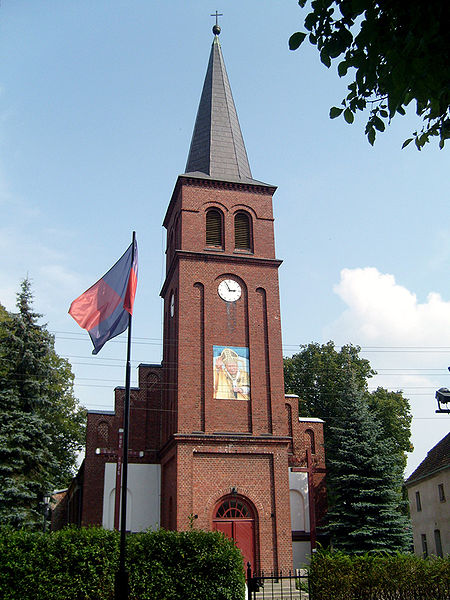
On May 4, 1969. the Chamber of National Remembrance was opened in the Municipal and Communal Cultural Center. It was a period when every self-respecting cultural institution or school in Poland opened chambers of national remembrance. On July 15, 1971. a bicycle factory was launched as a branch of Predom-Romet Bicycle Factory. Thanks to this, in 1974. a cycling section was established at LZS Orkan. It was only on September 1, 1971. The Basic Agricultural School in Mirosławiec was launched. On February 10, 1974. a battle memorial in the form of a tank was unveiled.

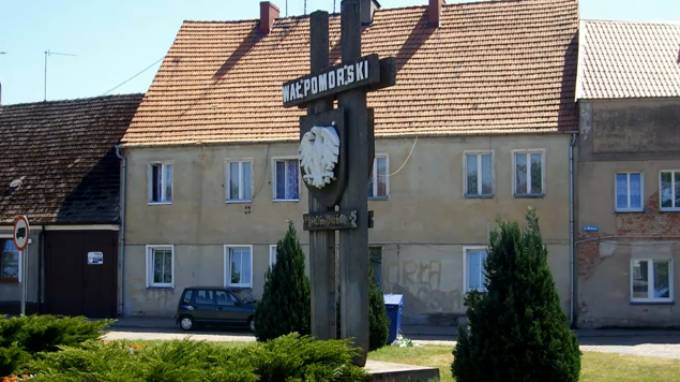
On June 1, 1975. due to the administrative reform, the City and Commune of Mirosławiec to the Pilskie Voivodeship. On March 16, 1985 the Museum about the breakthrough of the Pomeranian Wall was opened. On July 1, 1994. the first free elections for the position of the Mayor of the City and Commune of Mirosławiec were held. MSc. Edward Ząbek. On February 10, 1994 The 50th anniversary of the liberation of Mirosławiec was celebrated. In 1999. as a result of the administrative reform, Mirosławiec found itself in the West Pomeranian Voivodeship.
The city of Mirosławiec at present. 2011 year.
Until 1975. The city belonged to the Szczecin Province. In the years 1975-1998. The city belonged to the Pilskie Voivodeship, and since 1998. is part of the West Pomeranian Voivodeship. It is located in the Wałecki Poviat and is the seat of the City and Commune of Mirosławiec. The headquarters of the forest inspectorate is located here. The local Roman Catholic Church is the seat of the Deanery. Geographically, the city is situated in the eastern part of the Wałeckie Lakeland, north of the Korytnickie Lake and east of the Korytnica River.
On 01/01/2009 the area of the city was 2.13 square km. According to the data from June 30, 2009. The city had 2,616 inhabitants.
The city currently (2011) has very little chance for development. After the optimism of the 90s of the twentieth century, nothing is left. First, the post-communist president Aleksander Kwaśniewski in 2000. vetoed the law on the general enfranchisement of Poles, which opened the door to the return of property to the German plague. Later, rail transport was completely liquidated. The motorway planned nearby was not built. In the first decade of the 21st century, no large production plant was established in Mirosławiec. And in 2010. the liberal government of Prime Minister Donald Tusk abolished 12 BLot.
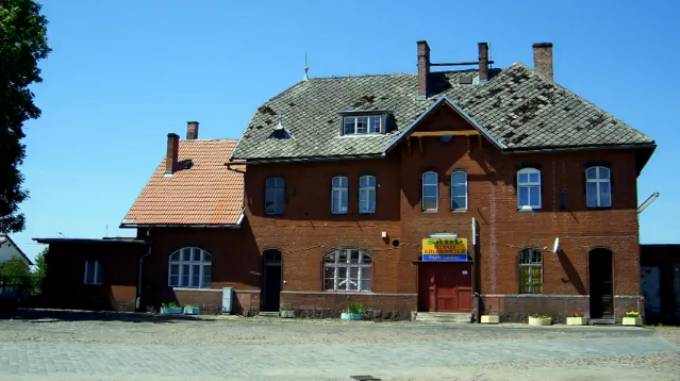
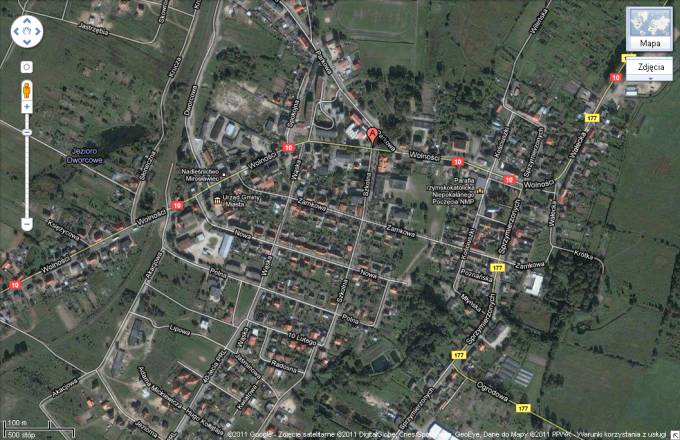
History of the Mirosławiec Airport. The times of German domination.
The history of the Mirosławiec Airport dates back to the times of German domination. The idea to build and its implementation fell on the years right after Hitler and his party took power in Germany. The concept of building an airport right here resulted from the implementation of certain objectives of the new Germany's policy and it is worth considering for a moment. In 1933, Hitler commissioned the development of a training system for his subordinates. Soon the relevant plans were ready and their implementation began at the beginning of 1934. The training of the German commanding staff was to take place in special training centers called "Ordensburg", which was a reference to the history and tradition of the Teutonic Order. : in the Rhineland ("Ordensburg Vogelsang"), in Bavaria ("Ordensburg Sonthofen") and in West Pomerania ("Ordensburg Crossinsee").
The latter center was established in a relatively short distance from Mirosławiec, on Lake Krosino, near Złocieniec. The official opening ceremony took place on April 24, 1936, attended by Hitler in person. This center was a huge complex of buildings and associated facilities, located on or nearby Krosino Lake.
It was precisely for the needs of this center that in the period 1935 - 1936, an airport that exists to this day was built near Mirosławiec (in the town of Schonfeld). In the period 1938-1939, the airport was expanded, which was associated with the planned aggression against the Republic of Poland.
Little is known about the infrastructure of the then airport. It certainly had a ground (grass) runway, with dimensions of about 1,000 m x 200 m. All buildings were made of wood, and for a simple reason - there was no shortage of wood for construction. Certainly, the first facility was a sawmill, where the employees did not complain about the lack of work. Certainly, several dozen residential and storage barracks were built. One of them was adapted to perform the function of the Airport Headquarters. Most likely it had a kiosk on the roof that served as the air traffic control tower at the time. There must be a propellant and lubricant store on the site. As for the hangars, two glass hangars were probably completed in 1939. Their bases were about 30 m x 20 m.
From this airport, among others, in September 1939, He-111 P bombers for air raids on Poland took off. The short distance from the border made this task much easier. In the period 1941 - 1942, the airport acted as a training unit for young airmen, mainly on-board shooters. Until 1943, the airport was not used intensively. Located far from the eastern front, it could not serve any operational purposes. The revival took place in 1943, when the airport undertook intensive training of fighter pilots on the Fockewulf FW-190 and Messerschmitt Me-109 F planes. They were almost one hundred percent very young people. At that time, the German aviation began to experience an acute shortage of fighter pilots, which was a consequence of the losses both in the east and in the west. Pilot training continued until the fall of 1944, when the situation on the Eastern Front forced the airport to be reused for combat purposes, which, however, lasted for a relatively short time.
In January 1945, Colonel Hans -Urlich Rudel was sent to the airport with his squadron code-named "Immelmann". Pilot, flying the Ju-87. Rudel became famous as a tank destroyer. By the end of the war, it had 2,530 combat flights completed and, reportedly, about 500 tanks destroyed (the state of equipment is estimated at 2-3 armored divisions). Years later, in the published book "Mein Kriegstagebuch", he recalled his stay at the Mirosławiec Airport in the following way: "The front of the Odra River has stabilized somewhat. I received a telephone order for immediate ferrying with my squadron to Mirosławiec ("nach Markisch Friedland in Pomern") in Pomerania, where the situation was becoming even more dangerous than in Silesia. (..) Dense snowstorm made it difficult to navigate in a dense formation; that is why we started in threes, (..) trying (..) to reach Mirosławiec (.). In a dense snow blizzard, in complete darkness, I land in Mirosławiec with a few machines. The Rudla squadron entered combat the next day, operating over Wałcz. Trzcianka, Wieleń and Człopa. Rudel recalled: "Now all day long" stukas "with the sign of the Teutonic Order (" deutschritterordens ") are taking off. As six hundred years ago, so now is the struggle against the East. It is very cold, there is a layer of approx. 40 cm of fluffy snow at the airport, near; the clash of that snow dust blows between the parts of the parcel lock mechanism, and in the air this dust freezes immediately. After one or two shots, the weapon fails to obey. I'm trembling with rage. "(..)" The T-34 is pushing west. Sometimes it takes a single shot for a tank to explode, but more often, unfortunately not. Precious days passed before I had enough manpower to keep the runway free The number of tanks is terrifying; we fly in all directions, but the day would have to be three times longer. (.) To the east of Wałcz we inflict considerable losses on the Soviets, similarly to the south in the Człopa region and in the adjacent forest areas. most often in residential houses; it can be recognized by a cannon sticking out from the house. The back of the house is demolished. These houses will certainly not be inhabited by any Germans. So we shoot the engine from behind, no other way of attack is possible; the tank burns, and then blows up with the ruins of the house. (.) I never attack with bombs in these places, even if it would be desirable from a military point of view; that their own bombs would hit the German population who are already suffering from the Soviet terror. " So much for Colonel Rudel about the experiences related to the stay at the Mirosławiec Airport. Soon, along with his squadron, he was directed to the Frankfurt (Oder) area.
And this basically ends the reign of the German army at the Mirosławiec Airport. On February 10, 1945, the airport and the city were captured by soldiers of the 1st Polish Army. But at the airport, no Polish unit was based. The front quickly moved on.
The Mirosławiec airfield remained on the sidelines, partially destroyed by fire and bombing. Hidden in forests, relatively far away from Berlin, it did not arouse interest on the part of Russian troops. In Pomerania, where the Germans built many airports in 30 years, the Mirosławiec Airport was not an attractive one. Abandoned by the army, it became a place for looters' expeditions. First it was looted and then devastated. Let us not be surprised by such behavior. For many months (almost 3 years), the Russians maintained the temporary nature of the Polish administration in these areas. And the following decades took a makeshift, which was confirmed by the President of the Republic of Poland, Aleksander Kwaśniewski (post-communist), by vetoing the law on universal enfranchisement. And the ratification of the border on the Odra and Nysa rivers has not changed anything. Effects - the German population regained their property. Let me remind you once again - it was not the Poles who established the borders of the Republic of Poland.
Written by Karol Placha Hetman
